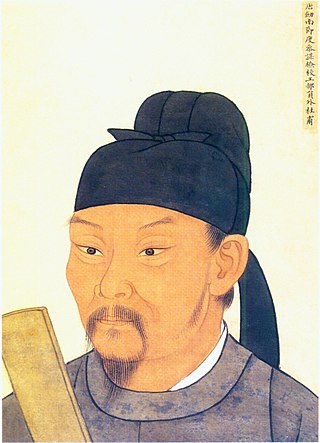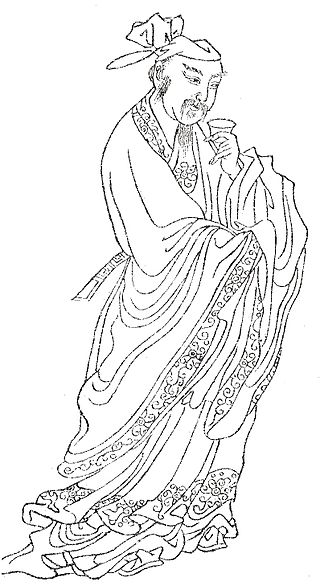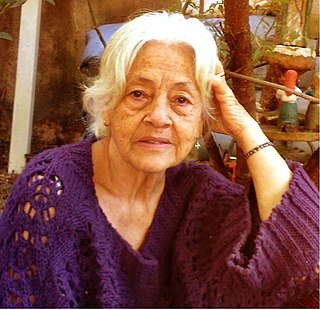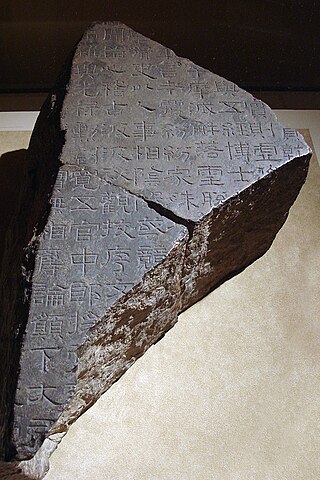Related Research Articles

Li Bai, formerly pronounced Li Bo, courtesy name Taibai (太白), was a Chinese poet acclaimed as one of the greatest and most important poets of the Tang dynasty and in Chinese history as a whole. He and his friend Du Fu (712–770) were two of the most prominent figures in the flourishing of Chinese poetry under the Tang dynasty, which is often called the "Golden Age of Chinese Poetry". The expression "Three Wonders" denotes Li Bai's poetry, Pei Min's swordplay, and Zhang Xu's calligraphy.

Chinese poetry is poetry written, spoken, or chanted in the Chinese language, and a part of the Chinese literature. While this last term comprises Classical Chinese, Standard Chinese, Mandarin Chinese, Yue Chinese, and other historical and vernacular forms of the language, its poetry generally falls into one of two primary types, Classical Chinese poetry and Modern Chinese poetry.

Classical Chinese poetry is traditional Chinese poetry written in Classical Chinese and typified by certain traditional forms, or modes; traditional genres; and connections with particular historical periods, such as the poetry of the Tang dynasty. The existence of classical Chinese poetry is documented at least as early as the publication of the Classic of Poetry (Shijing). Various combinations of forms and genres have developed over the ages. Many or most of these poetic forms were developed by the end of the Tang dynasty, in 907 CE.

Burton Dewitt Watson was an American sinologist, translator, and writer known for his English translations of Chinese and Japanese literature. Watson's translations received many awards, including the Gold Medal Award of the Translation Center at Columbia University in 1979, the PEN Translation Prize in 1982 for his translation with Hiroaki Sato of From the Country of Eight Islands: An Anthology of Japanese Poetry, and again in 1995 for Selected Poems of Su Tung-p'o. In 2015, at age 88, Watson was awarded the PEN/Ralph Manheim Medal for Translation for his long and prolific translation career.

Du Fu was a Chinese poet and politician during the Tang dynasty. Together with his elder contemporary and friend Li Bai, Du is often considered one of the greatest Chinese poets. His greatest ambition was to serve his country as a successful civil servant, but Du proved unable to make the necessary accommodations. His life, like all of China, was devastated by the An Lushan Rebellion of 755, and his last 15 years were a time of almost constant unrest.

Du Mu (Chinese: 杜牧; pinyin: Dù Mù; Wade–Giles: Tu4 Mu4; 803–852) was a Chinese calligrapher, poet, and politician who lived during the late Tang dynasty. His courtesy name was Muzhi (牧之), and art name Fanchuan (樊川). He is best known for his lyrical and romantic quatrains.

Meng Haoran was a Chinese poet and a major literary figure of the Tang dynasty. He was somewhat an older contemporary of Wang Wei, Li Bai and Du Fu. Despite his brief pursuit of an official career, Meng Haoran spent most of his life in and around his hometown Xiangyang of the Hubei Province living like a hermit, while creating poems inspired by its landscapes and milieu.

Robert Desnos was a French poet who played a key role in the Surrealist movement.
Yuefu are Chinese poems composed in a folk song style. The term originally literally meant "Music Bureau", a reference to the imperial Chinese governmental organization(s) originally charged with collecting or writing the lyrics, later the term yuefu was applied to later literary imitations or adaptations of the Music Bureau's poems. The use of fu in yuefu is different from the other Chinese term fu that refers to a type of poetry or literature: although homonyms in English, the other fu is a rhapsodic poetry/prose form of literature.

Adélia Luzia Prado Freitas is a Brazilian writer and poet.
The Three Hundred Tang Poems is an anthology of poems from the Chinese Tang dynasty (618–907). It was first compiled around 1763 by Sun Zhu (1722–1778), who was a Qing Dynasty scholar and was also known as Hengtang Tuishi. Various later editions also exist. All editions contain slightly more than 300 total poems. The number 300 was a classic number for a poetry collection due to the influence of the Classic of Poetry, which was generally known as The Three Hundred Poems.

Tang poetry refers to poetry written in or around the time of or in the characteristic style of China's Tang dynasty, and/or follows a certain style, often considered as the Golden Age of Chinese poetry. The Complete Tang Poems includes over 48,900 poems written by over 2,200 authors. During the Tang dynasty, poetry continued to be an important part of social life at all levels of society. Scholars were required to master poetry for the civil service exams, but the art was theoretically available to everyone. This led to a large record of poetry and poets, a partial record of which survives today. The two most famous poets of the period were Li Bai and Du Fu. The Qing dynasty selection, Three Hundred Tang Poems, has made Tang poetry familiar to educated Chinese in modern times.
Facing the Moon: Poems of Li Bai and Du Fu is a collection of English translations of Chinese poetry by the Tang dynasty poets Li Bai and Du Fu, translated by Keith Holyoak. Published in 2007, this bilingual collection includes an introduction to the poets and their work, and a bibliography. Holyoak's translations endeavor to capture key elements of the structure of the original poems, including their metric form and rhyme scheme.

Du Shenyan was a Chinese poet and politician. He was a poet of the early Tang dynasty, and one of whose poems was collected in the popular anthology Three Hundred Tang Poems.

Classical Chinese poetry genres are those genres which typify the traditional Chinese poems written in Classical Chinese. Some of these genres are attested to as early as the publication of the Classic of Poetry, dating from a traditionally, and roughly, estimated time of around 10th–7th century BCE, in what is now China, but at that time was composed of various independent states. The term "genres" refers to various aspects, such as to topic, theme, and subject matter, what similes or metaphors were considered appropriate or how they would be interpreted, and other considerations such as vocabulary and style. These genres were generally, but not always independent of the Classical Chinese poetry forms. Many or most of these forms and genres were developed by the Tang dynasty, and the use and development of Classical Chinese poetry genres actively continued up until the May Fourth Movement, in 1919, and still continues even today in the 21st century.

Han poetry as a style of poetry resulted in significant poems which are still preserved today, and whose origins are associated with the Han dynasty era of China, 206 BC – 220 AD, including the Wang Mang interregnum. The final years at the end of the Han era often receive special handling for purposes of literary analysis because, among other things, the poetry and culture of this period is less than typical of the Han period, and has important characteristics of its own, or it shares literary aspects with the subsequent Three Kingdoms period. This poetry reflects one of the poetry world's more important flowerings, as well as being a special period in Classical Chinese poetry, particularly in regard to the development of the quasipoetic fu; the activities of the Music Bureau in connection with the collection of popular ballads and the resultant development of what would eventually become known as the yuefu, or as the rhapsodic formal style; and, finally, towards the end of the Han dynasty, the development of a new style of shi poetry, as the later development of the yuehfu into regular, fixed-line length forms makes it difficult to distinguish in form from the shi form of poetic verse, and at what point specific poems are classified as one or the other is somewhat arbitrary. Another important poetic contribution from the Han era is the compilation of the Chuci anthology, which contains some of the oldest and most important poetic verses to be preserved from ancient China, as well as the transmission of the Shijing anthology.
Six Dynasties poetry refers to those types or styles of poetry particularly associated with the Six Dynasties era of China. This poetry reflects one of the poetry world's more important flowerings, as well as being a unique period in Classical Chinese poetry, which, over this time period, developed a poetry with special emphasis on romantic love, gender roles, and human relationships. The Six Dynasties era is sometimes known as the "Age of Fragmentation", because China as a whole through this period lacked unification as a state, at least for any extended period of time; and, instead, many states rose and fell, often overlapping in existence with other states. Which of the various states and dynasties constituted the "6" dynasties of the Six Dynasties period varies somewhat according to which of the traditional selection criteria are chosen. The Six Dynasties era covers several somewhat overlapping main periods including all of the following: the Three Kingdoms (220–280), Jin dynasty, the Sixteen Kingdoms, and the Southern and Northern Dynasties (420–589). Sometimes, chronological discrepancies occur in regard to the turbulent political events of the time, from which these traditional historical-era designations derive, together with the somewhat different chronology of poetic developments. Thus, neither the lives of the poets nor the trends in their poetry fit gently and neatly together with these period dates. Furthermore, conversions to the Common Era dating system can create further complications. However, regardless of the chronological difficulties, major developments of poetry during the Six Dynasties include formalizing the distinction between the Jian'an era regular yuefu and the shi style poetry, further development of the fu, theoretical work on technique, and the preservation of both Six Dynasties and earlier poetry by collecting and publishing many of the pieces which survive today into various anthologies consisting all or in part of poetry.
Sunflower Splendor: Three Thousand Years of Chinese Poetry is an anthology of around 1,000 Chinese poems translated into English, edited by Wu-chi Liu and Irving Yucheng Lo and published in 1975 by Anchor Press/Doubleday. Wu-chi Liu served as the anthology's senior editor. As of 2002, the book had been widely used in Asian literature studies. In 2002 Stacy Finz of the San Francisco Chronicle wrote that the book "was a best-seller".

Simians of various sorts are an important motif in Chinese poetry. Examples of simian imagery have an important place in Chinese poetry ranging from the Chu Ci poets through poets such as Li Bai, Wang Wei, Du Fu, and more. Various poetic concepts could be communicated by the inclusion of simian imagery in a poem, and the use of simian allusions can help provide key insights into the poems. The use of simians in Chinese poetry is part of a broader appearance of macaques and other monkeys in Chinese culture as well as the monkey-like gibbons and sometimes monkey-like creatures from Chinese mythology.
References
- ↑ Watson, B. (translator) (2002). The Selected Poems of Du Fu. New York: Columbia University Press, ISBN 0-231-12829-0.